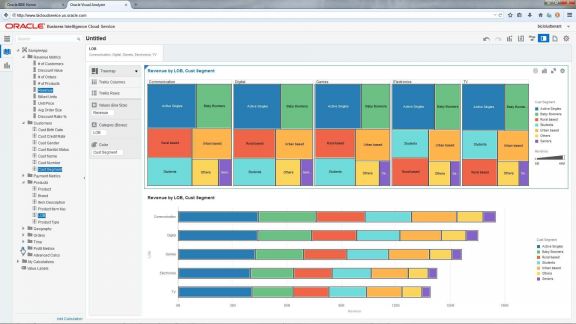How many changes would you tolerate on a train journey before you decided it was easier to drive?
To develop the analogy, Oracle has over the last 15 years developed many stations, but none of them are directly connected. Acquisitions of Hyperion, Siebel Analytics, Endeca, Inquira and others, as well as the development of appliances and Cloud solutions have created a complex landscape, made even more confusing with third party managed stations from, for instance Insight Software, and the development of add-ons such as Claremont’s own Payroll Control Centre and Oracle’s Analytic Applications. And finally, can I get to the Cloud … by train?
The context for this blog is that Oracle has de-supported Discoverer. In practice, you could continue using Discoverer, but you are unlikely to save any support money, as the tool was probably free in the first place. You will also have to deal with a small business risk, especially as you upgrade the technical environments on which Discoverer sits. But most organisations want to change anyway because they recognise that Oracle is no longer investing in the technology, so it will become harder to do business critical things with the tool.
At this point, I could list all the technology options and explain what they do, but you could just as easily go to Oracle.com and read for yourself.
Instead, I’ll focus on three business scenarios that relate to the kind of situation that often arises;
- You are using Discoverer quite successfully, have good in-house skills and are worried about de-support.
- Discoverer is mainly used to extract data into spreadsheets and you don’t have anyone who technically understands it. It is not generally liked or used widely.
- The business has a strategy to build in the Cloud and cannot afford to employ technical staff to manage reporting.
Scenario 1 – You like Discoverer
Organisations have worked out that Discoverer is not a bad tool, and have invested in making it work for the organisations best interests. They have developed views from E-Business Suite and may even have built Discoverer reports against a data warehouse. The end user layer has been set up to support end user queries and some reports have been developed as dashboards on their preferred intranet site.
Oracle attempted to build some technical upgrade routes for these customers, but very few found them useful, as they demanded too much manual intervention, did not migrate the business areas, didn’t work predictably, and didn’t allow a confederated view of the data. Funnily enough, it actually worked best where customers had built star schemas on data warehouses. However, that was a very small minority of Oracle customers.
The way to address this could be to utilise the views as data sources in a vanilla OBI setup. Or they could essentially be materialised into a data warehouse, if the organisation is worried about the performance impact on the source environment and wants reports to run appreciably quicker. You could blend (federate) both approaches with OBI, for instance combining trend analysis over the last 3 months (data warehouse) with on-the-day end-of-month analysis for closing invoices (views).
Scenario 2 – We need a change
Scenario 1 is not very common, especially as most Discoverer users have used it as a free tool within E-Business Suite. Organisations have not invested in the tool and may have allowed it to fall into disrepair over time. However, some reports are critical, so you cannot just switch it off.
These organisations tend to already understand they need to do more with the information they have. Typically there is talk of investment in an Analytics tool and some have dabbled with data visualisation tools like Tableau or Qliktech. Some are extending their Microsoft BI capabilities and some have invested heavily in Business Objects or Cognos, with a data warehouse, but have not yet integrated the Discoverer reports.
Oracle has developed a set of Analytic Applications, which can be implemented in 3 months, as they have prebuilt data extraction, transformation and visualisation. No one suggests that these will do everything you want out of the box, but, nearly all organisations who have invested, will admit it does a lot for them and demands less management than a custom data warehouse.
There is a significant cost attached, but this is more than compensated by the savings realised from lower development costs over time, fast access to good quality and robust data, and less time spend building and interpreting out of date spreadsheets.
Much like Cloud Applications, this philosophy provides end users with an end-to-end reporting solution and then asks the question ‘what else do you need?’. Rather than asking them what they want out of the tool.
The costs could also be somewhat less than the market perception, which is currently over £100,000.
Because this scenario assumes the organisation wants a strategic change to reporting, it is no surprise that there is no simple migration from Discoverer. Brave customers tell their end users they are switching off Discoverer and that they should ‘find’ their reports in the new environment. Others allow both environments (Analytic Applications and Discoverer) and will gradually retire Discoverer.
Scenario 3 – Time for the Cloud

These organisations have decided that they want to remove the costs of infrastructure and IT support from the business by deploying what they can on the Cloud. Applications such as Salesforce and Oracle HCM Cloud are managed by the vendor and end users simply use the tools.
In the Analytics world, this is not simple. Reporting needs to work now against all applications, whether they are in the cloud or on premise. Unless an organisation implements a complete IT solution in the cloud ground up (very rare), data will be held in multiple locations and cannot easily be reported on across data silos without additional tools.
Organisations therefore have two main choices – silo reporting to the application or build a separate data warehouse somewhere which can access data from all sources.
In the Oracle Cloud context, this translates into OTBI (Oracle Transactional Business Intelligence), the modular BI application (largely available now for Cloud Applications) and OTBI-E, which is (will be) a cloud-based Analytic Applications-like data warehouse, which collects data from the source applications.
And if that is a bridge too far, and if your organisation is trying out Tableau or similar, then Oracle has built a version of OBI, which sits in the Oracle Cloud, which allows you to supply data and build Analytics from scratch against any application, without any installation or technical management. You can buy BICS on a subscription basis, so the capital costs are low. Currently, data has to be supplied to BICS in a very manual way, but this is changing fast and will soon allow automated data collection to effect a near real-time experience.
And I haven’t even discussed PBCS (Planning and Budgeting Cloud Service) or some of the other prebuilt Hyperion Cloud solutions!
